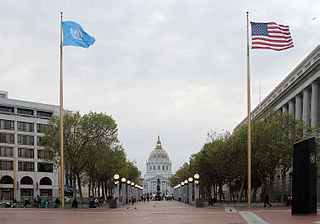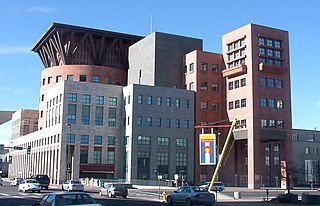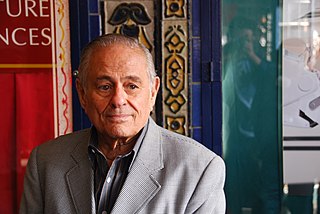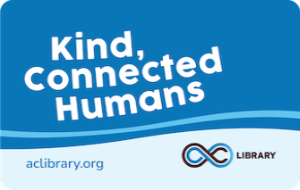
Nicholson Baker is an American novelist and essayist. His fiction generally de-emphasizes narrative in favor of careful description and characterization. His early novels such as The Mezzanine and Room Temperature were distinguished by their minute inspection of his characters' and narrators' stream of consciousness. Out of a total of ten novels, three are erotica: Vox, The Fermata and House of Holes.

The Civic Center in San Francisco, California, is an area located a few blocks north of the intersection of Market Street and Van Ness Avenue that contains many of the city's largest government and cultural institutions. It has two large plazas and a number of buildings in classical architectural style. The Bill Graham Civic Auditorium, the United Nations Charter was signed in the Veterans Building's Herbst Theatre in 1945, leading to the creation of the United Nations. It is also where the 1951 Treaty of San Francisco was signed. The San Francisco Civic Center was designated a National Historic Landmark in 1987 and listed in the National Register of Historic Places on October 10, 1978.

San Francisco City Hall is the seat of government for the City and County of San Francisco, California. Re-opened in 1915 in its open space area in the city's Civic Center, it is a Beaux-Arts monument to the City Beautiful movement that epitomized the high-minded American Renaissance of the 1880s to 1917. The structure's dome is taller than that of the United States Capitol by 42 feet (13 m). The present building replaced an earlier City Hall that was destroyed during the 1906 earthquake, which was two blocks from the present one.

The Dr. Martin Luther King Jr. Library is an 8-story public library and university library, located in downtown San Jose, California, which had its grand opening on August 16, 2003. As of 2018, it is the largest library building in the western United States built in a single construction project, with over 475,000 square feet of space on eight floors and approximately 1.6 million volumes. The King Library is a collaboration between the City of San José and San José State University: it is the main library for both San José State University and the San José Public Library system. In 2004 it was honored as Library of the Year by Library Journal and Thomson Gale, for its collaborative combination of the two functions as well as for the building. On its tenth anniversary in 2013 it was still the largest joint university-municipal library in the United States.

The San Francisco Public Library is the public library system of the city and county of San Francisco. The Main Library is located at Civic Center, at 100 Larkin Street. The library system has won several awards, such as Library Journal's Library of the Year award in 2018. The library is well-funded due to the city's dedicated Library Preservation Fund that was established by a 1994 ballot measure, which was subsequently renewed until 2022 by a ballot measure in 2007.

The Denver Public Library is the public library system of the City and County of Denver, Colorado. The system includes the Denver Central Library, located in the Golden Triangle district of Downtown Denver, as well as 25 branch locations and two bookmobiles. The library's collection totals more than 2 million items, including books, reference materials, movies, music, and photographs. Of that total, more than 347,000 items are in specific collections including the Western History and Genealogy Department, Blair-Caldwell African American Research Library, and Reference Department holdings.

Maurice Kanbar was an American entrepreneur and inventor who lived in San Francisco, California. He was particularly well known for his creation of SKYY vodka and was also noted for his extensive real estate investments.
The San Francisco Arts Commission (SFAC) is the City agency that champions the arts as essential to daily life by investing in a vibrant arts community, enlivening the urban environment and shaping innovative cultural policy in San Francisco, California. The commission oversees Civic Design Review, Community Investments, Public Art, SFAC Galleries, The Civic Art Collection, and the Art Vendor Program.

The Berkeley Public Library is the public library system for Berkeley, California. It consists of the Central Library, Claremont Branch, North Branch, West Branch, Tarea Hill Pittman South Branch—and the Tool Lending Library, which is one of the nation's first such libraries.

The Jacksonville Public Library is the public library system of Jacksonville, Florida. It primarily serves Jacksonville and Duval County merged areas, and is also used by the neighboring Baker, Nassau, Clay, and St. Johns Counties. It is one of the largest library systems in Florida, with a collection of over three million items. A division of the city government, the library has the third largest group of city employees after the city's Fire Department and Sheriff's Office. There are twenty branches and a Main Library in the system.

San José City Hall is the seat of the municipal government of San Jose, California. Located in Downtown San Jose, it was designed by Pritzker Prize-winning architect Richard Meier in a Postmodern style. It consists of an 18-story tower, an iconic glass rotunda, and a city council chamber wing, laid out within a two-block-long public square known as San José Civic Plaza. The tower rises 285 feet (87 m) above the plaza, making it the fourth tallest building in San Jose.

The Alameda County Library, in Alameda County, California, is a public library system that provides services from eleven branch libraries in the cities of Albany, Dublin, Fremont, Newark and Union City and the unincorporated communities of Castro Valley, Cherryland and San Lorenzo. According to 2005/2006 statistics, the total service area represents a population of about 522,000, and annual circulation is reported to be around 5.5 million. Its headquarters are located in Fremont.

The Stephen A. Schwarzman Building, commonly known as the Main Branch, 42nd Street Library or the New York Public Library, is the flagship building in the New York Public Library system in the Midtown Manhattan neighborhood of New York City. The branch, one of four research libraries in the library system, contains nine separate divisions. The structure contains four stories open to the public. The main entrance steps are at Fifth Avenue at its intersection with East 41st Street. As of 2015, the branch contains an estimated 2.5 million volumes in its stacks. The building was declared a National Historic Landmark, a National Register of Historic Places site, and a New York City designated landmark in the 1960s.

The Hillsboro Public Library is a two-location public library system in Hillsboro, Oregon, United States. First opened in 1914 in a Carnegie library building, the system provides services to a population area of 137,000 people. As of 2015, the system had a usage of 922,000 visits per year, with circulation nearly 3 million items per year. One library is located near downtown in Shute Park, with the other location in the central portion of the city near the airport. The Hillsboro Public Library is part of Washington County Cooperative Library Services (WCCLS), which ensures library service is available to all residents of Washington County. As of 2015, the director of the library is Stephanie Chase.

The New York Public Library for the Performing Arts, Dorothy and Lewis B. Cullman Center, at 40 Lincoln Center Plaza, is located in Manhattan, New York City, at the Lincoln Center for the Performing Arts on the Upper West Side, between the Metropolitan Opera House and the Vivian Beaumont Theater. It houses one of the world's largest collections of materials relating to the performing arts. It is one of the four research centers of the New York Public Library's Research library system, and it is also one of the branch libraries.
A guerrilla librarian is a person who may or may not be a professional librarian, but has otherwise taken up the stewardship of books or other material. This stewardship is usually outside the acceptance of authority figures, hence the guerrilla or underground nature of the action taken. Guerrilla librarianship can be politicized and occasionally controversial.

The Quintilla Geer Bruton Memorial Library is the public library of Plant City, Florida.

Civic Center Plaza, also known as Joseph Alioto Piazza, is the 4.53-acre (1.83 ha) plaza immediately east of San Francisco City Hall in Civic Center, San Francisco, in the U.S. state of California. Civic Center Plaza occupies two blocks bounded by McAllister, Larkin, Grove, and Carlton B. Goodlett, divided into a north block and south block by the former alignment of Fulton Street. The block north of Fulton is built over a three-story parking garage ; the block south of Fulton lies over a former exhibition space, Brooks Hall.

Brooks Hall is a disused 90,000 sq ft (8,400 m2) event space underneath the southern half of Civic Center Plaza in San Francisco; a parking garage occupies the space under the northern half.

The Sutro Library is a branch of the California State Library located in San Francisco on the campus of San Francisco State University. The foundation of the library's collection was assembled by former San Francisco mayor, engineer, entrepreneur, and philanthropist Adolph Sutro. The library was deeded to the State of California by Sutro's heirs with the stipulation that it never leave the city limits of San Francisco, filling his desire to provide the city with a public research library. It was formally given to California State Library in 1913, and opened to the public in 1917. Notably, half of the Sutro collection survived the "Great Fire" after the San Francisco earthquake of 1906. Collection highlights include 125,000 rare books, antiquarian maps, and archival collections, as well as a genealogical library.




















